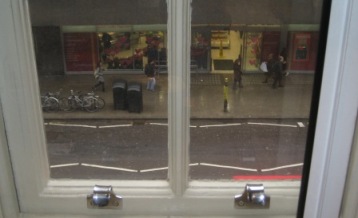
The weather was pleasant for almost the entire time I was in London. Like Wednesday, for instance. It rained a bit overnight; when I took this pic from the hotel window in the morning the streets were still wet. But it was dry during the day, and the temps were in the upper 40s to low 50s all week — plenty warm enough for walking around, and considering that we were getting a couple feet of snow back home at the same time, quite nice indeed ;-)
So. Day three.
I love Rochester and for a city this size, we have some nice museums. But needless to say it’s nothing like a world class art center like London. My Gracious Host took me to at least six museums in that city during my visit, plus the Louvre when we went to Paris.
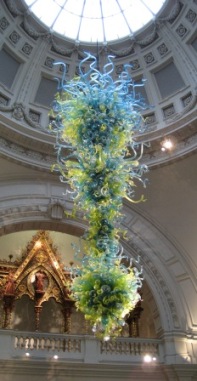
The experience was like a gigantic art buffet. (A free buffet — London’s museums don’t have a mandatory charge for general admission.) Obviously there was no way to even taste every dish. Instead we just wandered, and if something caught my eye, or my companion’s, we’d call the other over & pause & look.
On the 14th, our first stop was the Victoria and Albert. Here’s the Dale Chihuly chandelier that hangs in the museum’s entrance dome.
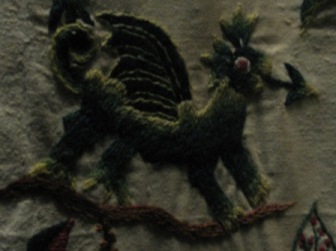
There was so much to see inside that, like I said, it was obviously pointless to try to make any real sense of it. Just pause if, for instance, you notice something with a pointy tongue.
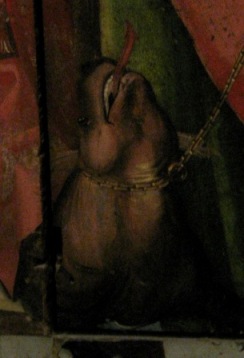 Or something else with a pointy tongue.
Or something else with a pointy tongue.
Pointy tongues aside, one of the things I noticed after some hours at the buffet is how art, once, was concerned so much with capturing (depicting?) moments within mythological narratives. (Including, of course, contemporaneous myths, e.g. political events.) I’m not suggesting this is an original idea, btw, nor a particularly profound one; in fact it probably says more about my own cultural orientation than any artist, living or dead. I’m so used to receiving cultural narrative via movies and television that the notion of someone actually sitting down and taking the time and energy to first imagine an event and then, god bless ’em, meticulously paint or sculpt it kind of blows my mind. It’s a commitment of such scale that it excludes frivolity pretty much by definition, doesn’t it.
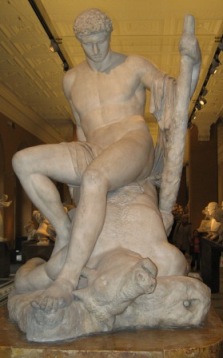
It’s also all but impossible to imagine anyone doing this sort of art today. Imagine, for instance, someone deciding he was going to paint a U.S. presidential cabinet meeting when some historical decision was being made — the decision to invade Iraq, for example. Who would bother, unless in the service of irony or caricature or the hope to cast shame? And if someone did, the ensuing discussion would center on the “accuracy” of the painting — because post-photography, we expect images that feature “real” elements (in the photographic sense of real) to correspond exactly in space in time to whatever is being “represented.” So you couldn’t, for instance, paint the invade-Iraq-decision scene as representational but also show Clinton in the room, or the elder Bush. Even though both men were very much present in the sense of having complicity in the event / in the sense of having contributed to it.
Maybe one reason mainstream art abandoned representation is that photography cost artists their courage to imagine scenes in mythological terms. Much easier to just blop a little paint on the canvas and call it a day. Faster, too.
Or maybe it’s because we’re wrestling with myth today in more overt or direct terms than we were once. Nobody’s willing to concede to the authority of a shared myth, so our art is naturally fractured and timid.
Jah, who knows.
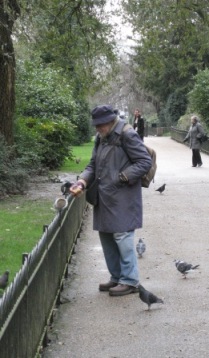
Anyway. From the V&A we ended up at Hyde Park. Passed a couple of pensioners feeding the birds and squirrels. I tried to get a picture of an English robin — they were flitting out from the bushes onto the pensioners’ hands to snatch whatever they were offering, crumbs or seeds — but I wasn’t quick enough. I did get a fairly decent shot of another bird I’d never seen before: a wood pigeon. They resemble the familiar rock pigeons you see all over in U.S. cities but are quite a bit larger.
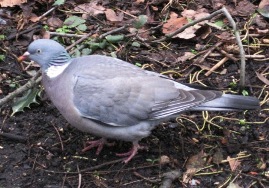
At one end of Hyde Park we paused to look at Kensington Palace, where Princess Di lived.
Lovely, but a bear to keep dusted, I understand.
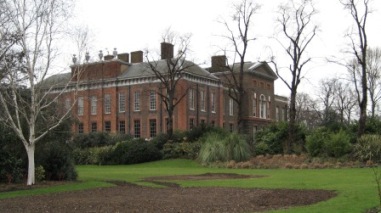
We didn’t go in.
We did go in St. James’s Church in Piccadilly, where William Blake was baptized in this font in 1757.
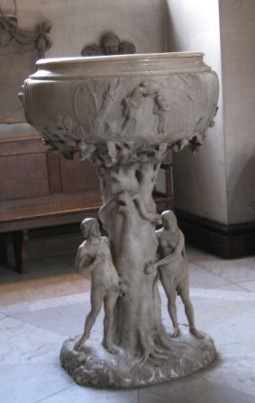
I think it was that same day that we went to Sir John Soane’s Museum (spelt right this post). No photography allowed inside, so I don’t have pics, but take my word for it, it’s worth a visit if you get a chance. Amazing collection of art and antiquities. Epitomizes the notion of a wealthy 19th century English Collector.
I forget where we ate that evening. Probably a pub. It was about that time, if I recall correctly, that my Gracious Host began exulting about my being such a cheap date, the way I kept volunteering for Guinnesses and pub grub :-D
But I know where we went afterward, because it was Valentine’s Day, and we went to see Madame Butterfly, which I mentioned a couple of posts ago.
Extraordinary climax to an extraordinary day . . . and after that, Paris.

Neat pics, and a great trip! One question, tho…
You lost me with, “Nobody’s willing to concede to the authority of a shared myth.” Could you explain what you mean?
John
What I mean is, today you have one guy who believes JFK was murdered by Martians, and another who believes he was never killed at all but staged the whole thing in order to escape public life and is living somewhere in Argentina with Marilyn Monroe. Two myths, and don’t bother trying to persuade either guy to concede to the authority of the other’s, because we’re all too smart for that any more. We’re all sure we have the inside information etc. It’s not so much that people never disbelieved the in-common myths — it’s reasonable to assume some did — but if they did their disbelief was less public . . . or anyway that’s what I’m proposing, or speculating.
Thought provoking post Mortensen! :-) The general view amongst art historians is that the invention of photography freed the artist from having to slavishly depict physical reality (portraiture, historical event etc al) forcing them to explore alternative pictorial syntaxs, which evolved into Impressionism, Expressionism, Futurism, and eventually new mythologies like ‘Neo-Romanticism’ in Europe. Unfortunately, certain people across the pond *ahem* chose to take things in a completely different direction – giving us Abstract Expressionism; opening the floodgates for The Idiots.
Regarding concensus myths, Jung believed that if you stripped indegenous peoples of their folklore, mythologies etc, they will eventually tail-spin into alcholism and depression. This is certianly true of Woo-woo Injuns and Australian Aboriginals, but if one looks at Americans, Europeans, and Japanese ( the latter who now have the highest number of hospital patients with mental illnesses in the world) the same behaviour is taking place, no doubt caused by a toxic mix of rampant commercialism and rootless liberalism.
Uh oh, not the floodgates for The Idiots!!!!
LOL